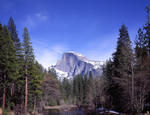Date: March 19, 2012
Workbook Designed to Help the Public Engage in Upcoming Public Meetings and Site Visits for the Merced River Plan
Yosemite National Park announces the availability of the Preliminary Alternative Concepts Workbook for the Comprehensive Management Plan for the Merced Wild and Scenic River Plan (MRP) on the park's website today. Hard copies of the workbook will be available next week. The goal of the MRP is to provide visitor access and protect resources within the Merced River corridor. The document provides a look at the preliminary alternative concepts of the MRP. This is the first opportunity for the general public to see what the park has developed, incorporating scientific analysis and public comment. These preliminary alternatives will be refined and become a part of the Draft Environmental Impact Statement (DEIS) for the MRP, which will be released in the fall. Copies of the workbook will also be provided to each individual attending the Workshops/Site Visits.
The public is highly encouraged to attend one of the upcoming Public Workshops, Site Visits, and Webinars where the draft alternatives will be analyzed and discussed. The meetings are a continuation of the park's outreach efforts from last fall in which the public was asked to provide input on what they would like to see included in the management alternatives evaluated in the DEIS. The MRP is a very important plan and will guide the future management of Yosemite within the Merced River corridor. These spring workshops are another chance for the public to review work in progress and provide input directly to park planners about a range of conceptual approaches to protecting river values and managing use within the corridor. The MRP will guide future decisions about transportation, camping, parking, lodging, employee housing and other administrative uses, restoration, and set user capacity - most notably within Yosemite Valley - and will establish the management strategy and actions for the next 20 years by modifying the General Management Plan.
The Workshop schedule is:
- Wednesday, March 28, 2012, 9:00 a.m. to 11:30 a.m., Yosemite Valley Auditorium
- Wednesday, April 4, 2012, 5:30 p.m. to 8:00 p.m., Golden Gate Room, Fort Mason Center, San Francisco
- Thursday, April 12, 2012, 5:30 p.m. to 8:00 p.m., El Portal Community Hall
- Friday, April 13, 2012, 1:00 p.m. to 3:30 p.m., Wawona Community Hall
The Site Visit schedule is:
- Wednesday, March 28, 2012, 1:00 p.m. to 3:00 p.m., meet at the Yosemite Valley Auditorium
- Thursday, April 12, 2012, 2:00 p.m. to 4:00 p.m., meet at the El Portal Community Hall
- Friday, April 13, 2012, 10:00 a.m. to 12:00 p.m., meet at the Wawona Community Hall
The workbooks can be viewed at http://parkplanning.nps.gov/mrpalternatives. For the latest information on the MRP and all park planning efforts, please visit www.nps.gov/yose/parkmgmt/planning.htm.




